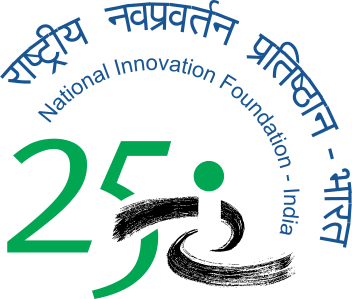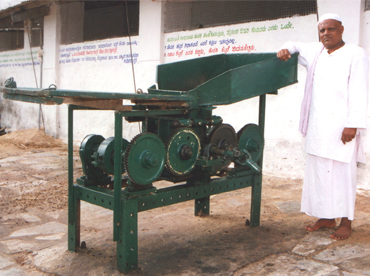A Device to Separate Tamarind Seeds
After spending about three lakhs rupees and six months of hard and intensive labour in 1994, he could finally design and develop a machine to separate tamarind seeds. It had a system wherein due to the sliding action of the pegs that were tapered at the end, the seed gets thrown out of the tamarind pod.
Tamarind Slicing for Pickles
The next step in pickle making was to cut the unripened tamarind into small pieces. The process was difficult and tedious. This led him to design a machine for slicing tamarind. The machine served multiple purposes and could do the job more efficiently and effectively.
Due to his work related to tamarind, people nick named him "hunase huccha", which means tamarind maniac.
Other Innovations
Abdul has been striving and struggling hard to discover the progressive methods that can fit into modern agriculture. In this direction he developed many other innovative, low-cost and farmer friendly technologies.
In 1974, as soon as he left school he developed a new kind of bullock drawn tiller capable of deep ploughing. Due to financial constraints he was not able to produce the tillers at lesser cost for market. Followed by the tiller, he developed a plough blade in which whetting was not needed. The blade did not get damaged much and hence remained sharp for a long period. The blade could be used in tractor ploughing too.
Ploughing blade manufacturing machine: This machine was used for sharpening the tractor harrow blade. Once the blade gets sharpened, it lasts long without much wear and tear. This reduced the fuel consumption to some extent.
Seed cum fertilizer drill: This machine was used for sowing seeds of different sizes ensuring proper spacing. It could be used for sowing seeds ranging from jowar to groundnut. It had a wooden roller with various sizes of depression to suit the size of the seed. The machine could also facilitate dispersal of fertilizers, mud and grass.
Water-heating boiler: It could boil water sufficient enough for bathing 20 people by using just five kg of wood chips, that too in five – ten minutes. The boiler had an in-built mechanism for multi-stage heating, which kept the water hot for nearly 24 hours.
Automatic sugarcane sowing driller: This was developed in response to the request of some farmers from Maharashtra to automate the sowing of sugarcane. Abdul Nadakattin took only 6 months to develop this driller, which was purchased by many farmers.
He also developed a wheel tiller, which has wheels on both sides and helps to maintain uniform speed of the tractor engine, iron wheel to avoid the wear and tear and high fuel consumption occurs normally with the rubber button tyres in the tractors and a bullock drawn tiller and ploughing blade.
He has many such small and big innovations in his name but all his creative pursuits have taken a heavy toll on his financial resources. He struggled with a debt worth lakhs and was forced to sell his agricultural implements. However, he did not relent to any of the hardships and continued to struggle. He established Vishwashanti Agricultural Research Centre at Annigeri, through which he sells his innovations. Through the support of Karnataka Government, many of his products are available to farmers at subsidised rates. He also works closely on some projects with the University of Agricultural Sciences, Dharwad. His factory is being managed by his sons and his daughter-in-law looks after the financial aspects.
Despite all the hardships, Abdul Nadakkattin continues his innovative spirit. His in depth knowledge in the agro-climatic conditions and the soil characteristics has made him an inspiration to the other farmers in his area.
Acknowledgements: Abdul Nadakattin’s profile published in Honey Bee newsletter (Honey Bee, 11(4) & 12(1): 11-12; 2000- 2001) is gratefully drawn upon.
Abdul Khadar (62) is an innovator, a social worker and an environmentalist. Believing in the principles of sustainability, he has always advocated cost-effective, eco-friendly and socially acceptable methods in agriculture. He has also developed a number of user friendly and useful innovations.
He hails from a place called Annigeri in Navalgund taluka of Dharwad district, which has a population of about twenty five thousand people. Annigeri and the surrounding areas have deep black soil and are well known for chilli and Bengal gram crops. Growing up in a place surrounded by agricultural fields, it was natural for Abdul to have inclination towards agriculture. The only son of his parents, Abdul was keen on going to school but his father wanted him to focus on agriculture solely. Right from childhood he had an observant nature and a very innovative bent of mind, as evident from his first innovation.
A Wa(h!)ter Alarm
No matter how hard he tried, Nadakattin could never get up early in the morning. None of the alarms just seemed to break his slumber. His innovative mind started thinking of a mechanism that could solve this problem. This led him to develop a ‘water alarm’ - his first innovation. He tied a thin rope at the end of the key of the alarm in such a way that when the key unwound itself, the string tied to the key got wound. The string was in turn tied to a bottle filled with water, when the key was completely unwound, the bottle would tilt and the water would fall on his face.
Growing Tamarind
Abdul had inherited 60 acres of land from his father. As in any other dry area, agriculture there faced the risk of unpredictable rain along with scarce groundwater reserve. Facing similar problem and looking for an alternative, he decided to practice horticulture. He planted mango, sapota and ber with chilli as an intercrop in 16 acres of his land. Sapota and ber were planted alternatively in between mango rows. Owing to the lack of sufficient water, the idea failed to take off. He then decided to cultivate tamarind when he observed that in an orchard that was left uncared for a long period, only tamarind plants were standing green and had borne fruits also.
In 1985 - a year of severe drought, he managed to transport water from a distance of two to three km. With much difficulty he planted 600 tamarind plants in pits in rows with spacing of 20 ft. The plants not only survived but continued to grow well. In 1990, inspired by the success he planted 1,100 more plants in ten acres. He thus was able to establish a 16 acre grove with about 1800 tamarind trees.
One Innovation Leads to Another
The success of growing tamarind with scarce but alkaline water was an innovation in itself. To overcome water constraints, he tried reclaiming water by a three-part filtration process and dug as many as eleven bore wells at a cost of two lakhs but only two of them yielded water. Later he dug six farm ponds to harvest rainwater. After monsoon, water from the bore well was used to pump into the ponds. The water was then used for flood irrigating the plants. He has also constructed underground tanks to preserve the pulp of tamarind. Pulp preserved in such a manner had a long shelf-life and could retain the original quality and flavour for a longer period. He then started value addition to the raw fruit by manufacturing pickles and jam. His wife and daughter made the pickle and jam, which was marketed as far as Hyderabad. He thought of another new experiment when he faced problem in making pickles. The process of making pickle was labour intensive and tedious as one had to first harvest tamarind from the trees and then separate seeds from the fruit manually. He conceived a unique technique for harvesting tamarind from the trees but did not go ahead due to high cost involved.








